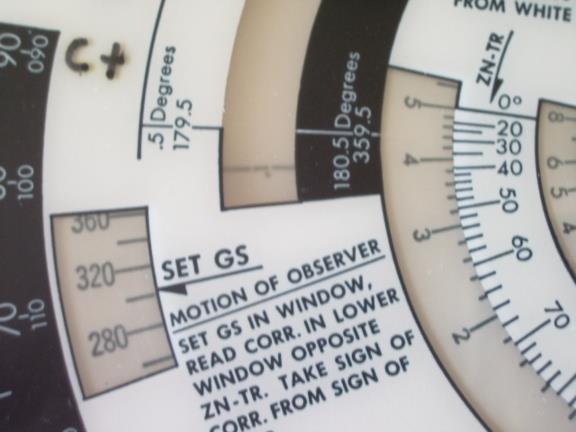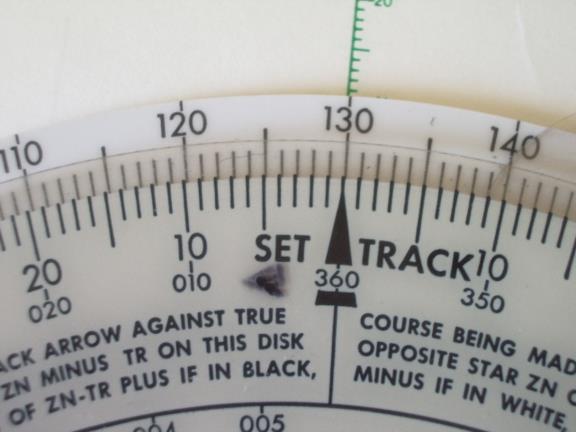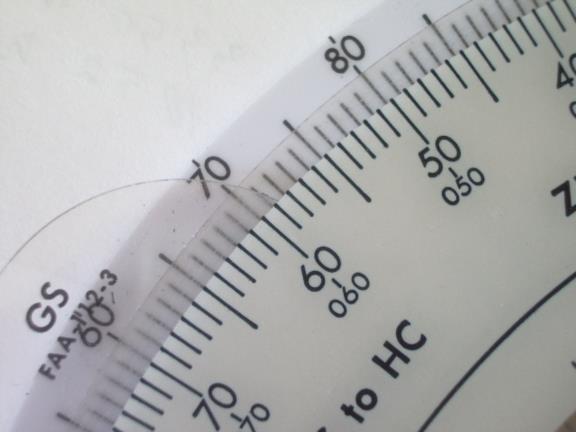
NavList:
A Community Devoted to the Preservation and Practice of Celestial Navigation and Other Methods of Traditional Wayfinding
From: UNK
Date: 2008 Jul 25, 19:48 -0700
The Polhemus makes it easy to figure the relative Zn. You place the "SET TRACK" pointer on the track of the aircraft ,130º as shown in the attached image. (see Pol2.jpg) Look at the next image (Pol3.jpg) for the second case, a track of 70º and you find the relative Zn, 60º on the inner scale.
The Polhemus also makes it easy to figure the sign to use for the adjustment, if the relative Zn is on the white scale, meaning the body is ahead, then the sign is minus and if found on the black scale (the body is behind) then the sign is plus when these adjustments are made to Hc, the normal method. This same pattern is revealed in the two MOO tables, the top of the tables show the body ahead and the bottom has the body behind.
gl
glapook@pacbell.net wrote:
Now let's talk about the "motion of the observer" (MOO) adjustment. Every fix in the air is a running fix because the aircraft moves a considerable distance between the first and last sight. Assuming the normal eight minute spacing between the first and last shot, a slow airplane, say 100 knots, will have traveled 14 NM while a 450 knot plane will have traveled 60 NM. In marine practice the navigator will advance the earlier LOPs to cross them with the last shot. The MOO adjustment accomplishes the same thing. As an example of how this works consider a sun shot taken at 1000Z resulting in an observed altitude, Ho, of 35º 55'. After doing the normal sight reduction you end up with an Hc of 35º 45' at the chosen A.P and a Zn of 130º. This results in an intercept of 10 NM toward the body, 130º. To plot this LOP you draw the azimuth line from the A.P and measure off the 10 NM intercept toward the sun and plot the LOP perpendicular to the Zn. Then, two hours later at 1200Z you take another altitude of the sun and to obtain a 1200Z running fix you must advance the 1000Z sun line to cross the 1200Z line. There are three ways to advance the LOP. First, you can pick any spot on the LOP and lay off a line in the direction of travel of the vessel, measure off the distance traveled along that line, make a mark there and then draw a line through that mark that is parallel to the existing LOP and label the advanced LOP "1000-1200Z SUN." A second way is to advance each end of the LOP and then just draw a line through these two points, this avoids having to measure the azimuth when laying down the advanced line. The third way is to advance the original A.P and then from the ADVANCED A.P. plot the LOP using the ORIGINAL intercept and Zn. Any of these methods will produce the same advanced LOP. Now let's consider a simple case. Suppose the vessel's course is the same as the Zn, in this case, 130º and the vessel's speed is 20 knots meaning it has traveled 40 NM in the two hour period. In this simple case we can just extend the Zn line an additional 40 NM and then plot the advanced LOP at that point. So, the LOP is now 50 NM from the original A.P., the original 10 NM intercept plus the additional 40 NM that the vessel has traveled on the same course as the azimuth. Since we have no interest in actually plotting the 1000Z LOP, as we are just planning on having the 1200Z running fix, we can skip drawing the earlier LOP and just plot the advanced LOP by adding the distance traveled to the original intercept to get a total intercept now of 50 NM and using that adjusted intercept to plot the advanced LOP using the ORIGINAL A.P. This method also creates the exact same advanced LOP as the other three methods. This last described procedure is how the MOO table is used. Look now at the MOO table, page 4 of the PDF in my original post. Assume now we are in 300 knot airplane and the first sight is taken at 1152Z, eight minutes prior to the planned fix time. At the top of the column marked "300" knots ground speed you find the number "20" showing that the plane will travel 20 NM (and so the altitude of the body should change by 20 minutes of arc) in a 4 minute period. Also notice that the top row of values are marked for a relative Zn of 000º meaning the body is directly ahead, as in our example. The plane will obviously travel 40M in the normal 8 minute period from the first to the last shot of a three star fix. The sign convention is the same as that for the MOB table so simply draw a horizontal line across the center of the table and place a big minus symbol for the top half and a big plus mark for the bottom of the table. If the body is in front of you the sign is minus and the sign is plus if the body is behind you. With these markings we can take out of the table a minus 20' value for our example and double it to have a total MOO adjustment of minus 40' to apply to the Hc. Let's do the math. Hc of 35º 45' minus 40' gives us an adjusted Hc of 35º 05'. Since the Ho is 35º 55' we compute an intercept of 50 NM TOWARD and plot the LOP using the ORIGINAL A.P. and Zn and this new adjusted intercept. You can see that this method produces the same advanced LOP as the previous methods. In the more normal case the course will not be the same as the Zn so the change in altitude will be less since the maximum change occurs when the body is straight ahead or directly behind the aircraft. The change in altitude due to MOO is computed by the cosine of the difference between the Zn and the course ( "track" in the air), the relative Zn multiplied by the maximum change possible, the zero degree relative Zn case. So, in our example, if the track of the the plane (course) were 070º then the relative Zn would be 60º (130-70=60) and we would look in the table for that relative Zn in the 300 knot column and take out a value of 10' which we would expect since the cosine of 60º is .5 so the MOO should be one half of the maximum possible for a 300 knot ground speed. In practice, the MOO and the MOB adjustments are totaled and then multiplied by the adjustment periods covered, (4 minutes on pages 4 and 5 and one minute on pages 6 and 7) to arrive at the total "motions" adjustments. gl On Jul 23, 2:58 am, "Gary J. LaPook" <glap...@pacbell.net> wrote:Before I can give an example of how celnav is done in flight I must explain how some things are done differently in flight. The first thing to discuss is the "motion of the body" adjustment. The marine practice is to take the sight, consult the almanac for the GHA of the body (or Aries) for the even hour before the sight and then add an increment for the minutes and seconds after the hour. The navigator then chooses an assumed longitude to make the the LHA used in the computation a whole number of degrees. It is done differently in flight. The flight navigator plans a fix time on the hour or at even ten minute intervals after the hour (the Air Almanac publishes data for every ten minutes) and takes out the GHA without any interpolation. He then chooses an assumed longitude to make a whole number of degrees of LHA and computes his Hc based upon this. Since two out of the three sights will be taken earlier than the fix time it is necessary to make adjustments to allow for this and this is what the "motion of the body" adjustment is all about and this is how it works. Think this one through. Imagine your latitude is on the equator and you are shooting a star directly west of your position, azimuth 270º. Since the earth turn 15' per minute of time, (15 nautical miles) the altitude of that star will get lower at the same rate, 15' per minute and 60' in four minutes. Attached are pages from H.O. 249 to illustrate this. Look at the first column on page 8 of the PDF file which is the 0º page of H.O. 249 volume 2 and you will see that the altitude decreases exactly one degree (60') for each one degree increase of LHA which takes four minutes of clock time. This also works with H.O. 249 volume 1, see page 11 and look at Procyon at LHA Aries of 45 to 48. What happens at a different latitude? The earth still turns at the same rate but the minutes of longitude become smaller as you move away from the equator based on the cosine of the latitude. For example, at a latitude of 60º a degree of longitude is only half as long as it is at the equator since the cosine of 60º in .5 (30 nautical miles) and the change of altitude for a sight on an azimuth of 270º should also be one half or 30' per degree of LHA change. Look at the all columns on page 10 of the PDF file, which is the 60º page, at LHA 85º to 90º which results in a 90º (270º) azimuth and you will see that the altitude changes at the predicted rate, 30' per degree of LHA change. Also look at Capella for LHA 18 to 32 on page 13 to see that this also works for selected stars. But what happens if the azimuth is not straight east or west? In this case the change of altitude is related to the cosine of the difference in the azimuth from east or west (which just happens to be the same as the sine of the azimuth) times the rate of change for the straight east and west cases. Using, for example, cases where the azimuth is 30º (sin is .5), which is 60º (cos is .5) from east, the change in altitude should be at half the rate of the east case since the cosine of 60º is .5. Look at page 8 for 0º latitude LHA 6 to 7 and declinations of 11 to 12 (producing azimuths of 30º) show changes of altitude at a rate of 30' per degree of LHA change, just as expected, one half the rate for the straight east case. Look at page 9 for the 60º latitude, LHA 25 to 28 and declination zero for 150º azimuth gives a rate of 15' per degree of LHA change (one half of one half of 60') and look at page 11, Capella LHA 115 to 117 and page 13, Betelgeuse LHA 64 to 65 for examples for selected stars. These changes are the basis for the "Motion of the Body" (MOB) adjustment tables attached as pages 5 and 7. Review these tables and you will see they produce the same resulting changes in altitude as shown in the previous discussion. Another way to look at this is that you are interpolating for minutes of LHA (LHA not being whole degrees) as discussed in the previous thread regarding such interpolations using minutes of time rather than minutes of LHA as the entering arguments. Now we come to, what might be confusing, the sign to apply to these adjustment. Consider the first example, on the equator looking straight west. Since the altitude is decreasing as time goes by, if the sight is taken before fix time (the time used for the computation) then the measured altitude, Hs, should be higher than that computed for the fix time by the amount shown in the "MOB" table or 15' higher for each minute the sight is earlier or one degree if the shot is four minutes before fix time. This adjustment would be added to the Hc for the fix time to compute the Hc for the earlier sight so the sign would be "+" so as to arrive at the same intercept. So for any body observed to the west the sign will be "+" and, by the same logic, the sign will be "-" for any body observed to the east. If a shot were taken after the fix time (which is not normally done) you would reverse the signs of these adjustments. The MOB table and also the MOO tables have a confusing table specifying what sign to use. You would use the listed sign if the sight were earlier than the fix time and the adjustment was to be applied to the observed altitude. Since normal practice is to make the adjustment to Hc, not to Ho, you must reverse the listed signs. If the shot were taken after the fix time you would reverse the already reversed signs and used the listed signs (whew). But for normal flight navigation cases just remember to reverse the listed signs as you make the adjustments to Hc. The next installment will discuss the "motion of the observer" adjustment. gl Gary J. LaPook wrote:I was alaready thinking about doing that and will try to get it done in the next couple of days.gljean-philippe planas wrote:Gary,I also enjoyed your very clear article. However, could it be possible that you provide the list with a practical exercice (example) with figures taken from a real LOP computation involving 3 bodies shooting in the air to illustrate the process? JPP--- On Sun, 7/13/08, Frank Reed <FrankRee...@aol.com> wrote:From: Frank Reed <FrankRee...@aol.com> Subject: [NavList 5822] Re: Celestial up in the air To: "NavList" <NavList@navlist.net> Date: Sunday, July 13, 2008, 3:12 PMGary,I very much enjoyed your article and learned quite a bit from it. Well- written and clear!-FERHO 249 extracts .pdf 344KDownload
--~--~---------~--~----~------------~-------~--~----~
Navigation List archive: www.navlist.net
To post, email NavList@navlist.net
To , email NavList-@navlist.net
-~----------~----~----~----~------~----~------~--~---









